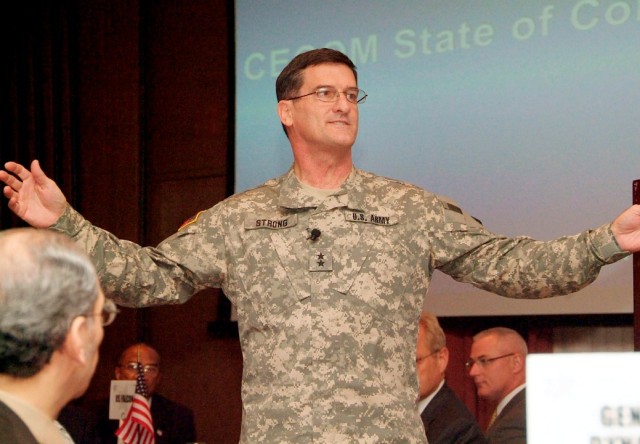FORT MONMOUTH, N.J. -- In its efforts to support the warfighter the CECOM LCMC is committed to supplying the Soldier with "world class" equipment, technologies and field support.
"If someone asks you 'What is the state of CECOM',' the answer is dynamic and committed," Maj. Gen. Randolph P. Strong, commander, CECOM Life Cycle Management Command, said recently during the Annual Combined Professional Association State of Command Luncheon.
"Dynamic as in active and changing; committed as in dedicated to the Soldier and fully engaged," he said. Strong delivered his assessment on Dec. 8.
The mission of CECOM LCMC is to help provide the warfighter with the best equipment and systems available, while its vision is to become the premier organization within the Department of Defense.
Although the goals may sound simple, keeping ahead of the needs of the Soldier is a great challenge, Strong said. In an effort to overcome some of these challenges, Strong provided the audience with a list of his top three priorities upon which he intends to focus: overseas contingencies operations, reset and Base Realignment and Closure (BRAC).
As part of his goal for efficient overseas contingencies operations and in line with the current agreement to pull United States Soldiers out of Iraq by 2011, Strong highlighted the enormous drawdown effort of the United States' presence in Iraq. As American forces pull out, and American base camps decrease from more than 250 to possibly as low as 10, the vast amount of equipment needs to be reduced as well, he said.
The equipment will be sent where it is needed--whether for immediate alternate operational requirements such as those in Afghanistan, or returned to the United States to be repaired and put into a larger pool to meet longer-term Army needs.
To help streamline the effort, CECOM LCMC has established the Drawdown Special Project Office (SPO) to coordinate the successful reduction of equipment fielded in Iraq over the past six years.
Overseas contingencies operations also include supporting the recently announced buildup of 30,000 troops in Afghanistan, as well as sustaining the forces that have deployed. The fielding of equipment and support to current and new theaters of operations is a tremendous undertaking, Strong said.
"We have PEOs [Program Executive Offices] and CECOM LCMC doing that buildup," Strong said. "There will not be conventional signal battalions going in to provide the network. There will be a lot of commercial off-the-shelf equipment, and a lot of SNAP satellite systems and VSAT terminals."
SNAP refers to Secure Internet Protocol Router (SIPR) and Non-secure Internet Protocol Router (NIPR) Access Point terminals. VSAT means Very Small Aperture Terminals.
Strong cited reset as another top priority. When electronic equipment comes back from Iraq and Afghanistan, it needs to be refurbished and repaired before it can be sent back to the field.
To fully support the warfighter, the organization operates on a very tight reset timeline, Strong said. BRAC is also high on Strong's priority list. Currently there is a plan to coordinate movement of the physical equipment and office materials to be transported to Aberdeen Proving Ground, Md.
The other half of the BRAC relocation consists of moving the personnel of CECOM LCMC to the site."BRAC is a huge effort, an emotional effort, and it has lots of moving parts to it," Strong said. "If you want to talk about something that is an emotional event, it's moving these 5,000 people out of Fort Monmouth."
Currently, a "revolution" is occurring within the military, Strong added. The kinetic Army is decreasing and the technical Army is increasing.
"I asked folks 'When was the last time they fired a main gun round downrange in Baghdad or Afghanistan,' and they said 'It has been a long time,'" Strong said.
Of course the Army still fires small arms and mortars, but it has been leaning away from the use of howitzers and main guns, Strong said.
The trend in modern warfare indicates a movement away from "heavily kinetic fighting" to a more information-based way of combating the enemy, with precision strikes being carried out through the use of advanced technologies. Huge amounts of information are being captured, collected and used to fight the war, he said.
"There is a whole other dimension to what is going on," Strong said. "Someday someone is going to write a book about the 'other war'; the war in technology and information in support of what we are doing in Iraq and Afghanistan."


Social Sharing